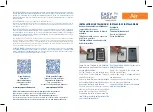
111
Safety Guidelines
Authorization for this model phone with all
reported SAR levels evaluated as in compliance
with the FCC RF emission guidelines. SAR
information on this model phone is on file with
the FCC and can be found under the Display Grant
section of http://www.fcc.gov/oet/fccid after
searching on FCC ID BEJP925.
Additional information on Specific Absorption
Rates (SAR) can be found on the Cellular
Telecommunications Industry Association (CTIA)
website at http://www.ctia.org
* In the United States and Canada, the SAR limit
for mobile phones used by the public is 1.6
watts/kg (W/kg) averaged over one gram of
tissue. The standard incorporates a substantial
margin of safety to give additional protection
for the public and to account for any variations
in measurements.
FCC Hearing-Aid
Compatibility (HAC)
Regulations for Wireless
Devices
On July 10, 2003, the U.S. Federal
Communications Commission (FCC) Report
and Order in WT Docket 01-309 modified the
exception of wireless phones under the Hearing
Aid Compatibility Act of 1988 (HAC Act) to
require digital wireless phones be compatible
with hearing-aids. The intent of the HAC Act is to
ensure reasonable access to telecommunications
services for persons with hearing disabilities.
While some wireless phones are used near
some hearing devices (hearing aids and cochlear
implants), users may detect a buzzing, humming,
or whining noise. Some hearing devices are
more immune than others to this interference
noise, and phones also vary in the amount of
interference they generate.
The wireless telephone industry has developed
a rating system for wireless phones, to assist
hearing device users to find phones that may be
compatible with their hearing devices. Not all
phones have been rated. Phones that are rated
have the rating on their box or a label located
on the box.
Summary of Contents for Thrill
Page 5: ...User Manual ...


































